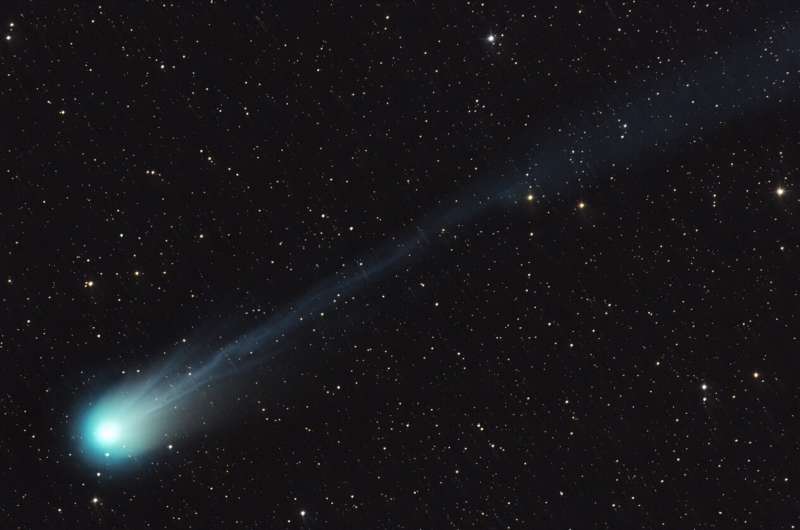This article has been reviewed according to Science X's editorial process and policies. Editors have highlighted the following attributes while ensuring the content's credibility:
fact-checked
trusted source
proofread
12P/Pons-Brooks: How and when to see the 'Devil Comet'

A Mount Everest-sized 'devil' comet making its first visit to the inner solar system in more than 70 years could be visible to the naked eye over the next few weeks.
The once or possibly twice-in-a-lifetime object, known as 12P/Pons-Brooks, is due to make its closest approach to the sun on 21 April, which is when it will be at its brightest.
For those in the northern hemisphere, the Halley-type comet is likely to be at its best visibility-wise between now and mid-April, although it won't be the easiest to spot.
"Don't expect it to be dazzlingly bright—the kind of image you see in photographs. It's not going to be like that," Dr. Robert Massey, deputy executive director at the Royal Astronomical Society, said in a video explainer.
"This is something that might just be visible to the naked eye if you don't have a moon in the sky if there's no light pollution, and if the weather is really clear, then you might stand a chance."
"But for most of us, we're going to need to pick up a pair of binoculars."
He added, "Ideally, look at one of the apps you can get on your phone, showing you where things are in the sky, or a finder chart of some kind. That'll really help you to track it down."
"And when you see it, it's likely to look like a sort of small, grayish fuzz, quite typical for many comets."
"But you will have the satisfaction of knowing you've seen this once-in-a-lifetime object."
Dr. Massey said stargazers should look to the west-north-west after sunset to catch a glimpse of Pons-Brooks, which completes its orbit once every 71.3 years and, therefore, won't be visible again until 2095.
The icy body, which is thought to have a nucleus about 34km (21 miles) in diameter, was recognized as a comet in 1812. However, it was seen as far back as the 14th century.
It is named after the French astronomer Jean-Louis Pons—who discovered it in the early 19th century—and British-American astronomer William Robert Brooks, who observed it on its next orbit in 1883.
There has been plenty of interest and excitement about Pons-Brooks over the past few months, driven in part by a couple of unusual features.
Firstly, photographs of its approach have captured the comet's "curious" green color.
"That's because it has a molecule called dicarbon," Dr. Massey explained. "What that does is it absorbs sunlight and re-radiates some of it with that characteristic green tinge."
The other attribute that has piqued the interest of observers worldwide is its occasional "horned appearance," earning Pons-Brooks the nickname "Devil Comet."
The reason these pointy horn shapes appear is because the icy object is classed as a cryovolcanic comet, meaning it regularly erupts with dust, gases, and ice when pressure builds inside it as it is heated.
Provided by Royal Astronomical Society




















